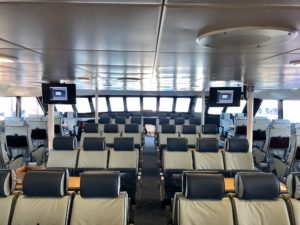When is the best time for wildlife and whale watching? What will we see?
The Salish Sea is world famous for observing a vast array of wildlife, including orcas, gray whales, humpback whales, minke whales, harbor porpoises, seals, sea lions, salmon, jellyfish, bald eagles, and blue herons. What whales and wildlife do in their day is up to them–we are privileged to observe these creatures in their natural environment and they control the show. Each day is unique and we don’t know exactly which exciting watch opportunities will arise.
How should I prepare for a tour?
We suggest the following:
- Arrive early. We begin boarding half an hour before the scheduled departure time. Note, we will leave the terminal promptly at 11 for March and April sailings, and 10:30 for sailings from May onward.
- Bring sun protection. We suggest hats, sunscreen, and sunglasses to help protect you from the sun and glare out on the water.
Wear warm clothes. We recommend layering clothes for any potential weather changes throughout the trip. - Bring binoculars if you have them. If not, binoculars are available for rent onboard.
- Consider a camera. We encourage our guests to capture photos onboard but will also offer the opportunity to purchase photos from your tour, taken by our naturalists.
- Curiosity at the ready. In addition to the beautiful sights and sounds of the Salish Sea, you will have access to various educational materials for the duration of your voyage, as well as commentary from and access to our professional marine naturalist who will guide you through the experience as we explore our waterways.
Are there different classes of service on San Juan Clipper?
Yes, there are two classes of seating for our whale watching tours, Standard (non-window aisle) and Premium (window aisle) seating. You will select your seats when making your booking and may choose between the lower or upper deck. The top outer viewing deck is open to all guests and is non-reserved seating to enjoy during our whale watching trips. View vessel seating chart for San Juan Clipper.
Is all seating indoors on the San Juan Clipper?
All reserved seating is located indoors and you will select your seats when booking your trip. You can also modify your booked seats at anytime by visiting our seat selection portal.
The top outdoor viewing deck of San Juan Clipper is open and available to all guests during our trips and has bench seating but is not used for reserved seating.
What are the seats like on the San Juan Clipper?
Our seating options include both Standard (non-window aisle) table options on the upper and lower deck as well as Premium (window aisle) seats. You will select your seats when making your booking. All guests are welcome to use the top outside viewing deck as desired during our trips. The outside viewing deck does not have reserved seating. The bow of the vessel is also opened up when we are stopped to observe whales and sealife.
Lower Deck Seating

Upper Deck Seating

Are there food and drinks available on the San Juan Clipper?
Yes, we offer a variety of locally-sourced food, drink and snack options that you can view on our online menu as well as various gift shop items.
How do I cancel or amend my whale watching reservation?
For the quickest response, please use our Contact Us page to submit your request or call our Reservations team at 800-888-2535.
What if I want to change my seats on San Juan Clipper?
If you are a booked guest, you can quickly change or confirm your San Juan Clipper seats by visiting our seat selection portal. Seating class changes between Standard and Premium seating will require agent assistance. Please call 800-888-2535 or submit your request via our contact us page.
Where do we get our parking validated?
Once onboard the vessel, an announcement will be made to retrieve parking validations at the galley. Should you miss this announcement, our crew will make sure you receive a parking validation ticket when arriving back at Pier 69 in Seattle.
Does your San Juan Clipper vessel accommodate wheelchairs?
Yes, our San Juan Clipper fast ferry can accommodate standard manual wheelchairs and has a standard manual wheelchair accessible restroom onboard. When booking online, please mark the box noting that a guest will require standard wheelchair assistance and contact us with any questions so that we may add a note to your reservation. Please note that we are unable to accommodate motorized wheelchairs on San Juan Clipper due to space and boarding constraints.
What happens if we don't see whales on our whale watching tour?
As part of our Whale Watching Guarantee, if you don’t see whales on your San Juan Clipper whale watching trip, you will receive a voucher for another trip on us. Please note that the voucher is not valid for seeing a specific whale species and is also not valid for a cash back exchange.
What is your cancellation and refund policy for the San Juan Clipper / Whale Watching?
Our cancellation and refund policy for all trips booked on the San Juan Clipper fast ferry and all associated whale watching tours is the following:
Standard Fare: Fully refundable for cancellations received 2 or more days prior to travel, non-changeable/non-refundable within 2 days. Should you want to change your booking in any capacity, a $15 USD fee will be charged.